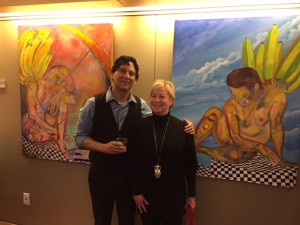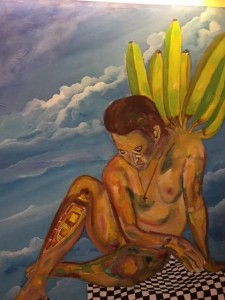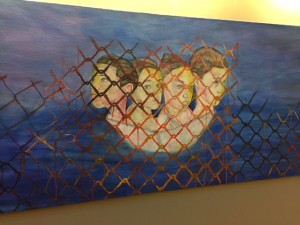 There are many definitions of art, but Raphael Diaz sums it up best; El arte es vida, la vida es arte, (art is life, life is art…). With his humble beginnings in Cuba, he has lived and traveled the globe. He moved to Rhode Island in 1991, and this is the place he calls home. At age 11, while living in New York City, his mother gave him 50 cents and he made the bold move to visit the Metropolitan Museum. This is where art came to him. While viewing a Modigliani masterpiece, he knew this was his calling. Painting became his world through his ethnic origin filled with Latin American cultures and customs. He paints life evolving not only with common themes like poetic feelings, then uses these tools to communicate and express pure existence.
There are many definitions of art, but Raphael Diaz sums it up best; El arte es vida, la vida es arte, (art is life, life is art…). With his humble beginnings in Cuba, he has lived and traveled the globe. He moved to Rhode Island in 1991, and this is the place he calls home. At age 11, while living in New York City, his mother gave him 50 cents and he made the bold move to visit the Metropolitan Museum. This is where art came to him. While viewing a Modigliani masterpiece, he knew this was his calling. Painting became his world through his ethnic origin filled with Latin American cultures and customs. He paints life evolving not only with common themes like poetic feelings, then uses these tools to communicate and express pure existence.
The “Silenced Voices” exhibit is currently on display at the Watson Institute, International & Public Affairs building at Brown University. I spoke with Raphael about his show and asked him about his powerful message.
Carrie Decker (Motif): Are there particular paintings you chose for your theme?
 Raphael Diaz: Yes, the title “Silenced Voices” was chosen based on a series of paintings where you have children floating in little paper boats in the middle of the ocean. These children can be DACA children. They have no voice or home in our society. They don’t know if they are going to make it or sink! There is no balance in our world.
Raphael Diaz: Yes, the title “Silenced Voices” was chosen based on a series of paintings where you have children floating in little paper boats in the middle of the ocean. These children can be DACA children. They have no voice or home in our society. They don’t know if they are going to make it or sink! There is no balance in our world.
CD: Do you work in different mediums?
RD: I work in different mediums, but painting is my first choice. I am a poet at heart and also a sculptor, but painting is my first choice. BTW, I think I am a great cook!
CD: You mentioned in your bio that you are a citizen artist.
RD: Yes, I was born in Cuba and my family escaped to the Dominican Republic. We followed my grandfather to Spain. When I was 8, we came to New York City, and I grew up in Washington Heights. My neighborhood was filled with amazing people from every ethnic background. Each person’s perseverance and struggles became my inspiration to create.
 With his Cuban-Latin culture there is always good comfort cuisine. His painted winged plantain figures are studies from the Italian Masters of Michelangelo and Raphael’s angels. A reflection of eating modest food from his homeland. The wire fences represent barriers. Raphael explains they still exist and need to be removed. The nude forms — are they angels within us or angels protecting us from harsh realities? The somber figures do not always look at the viewer, as eyes share a person’s presence. Are they in solitude or deep thought, or are they preserving the very nature of our soul? Each painted boat, musical instrument and Jewish dreidel incorporated in his pieces is a reminder of family, holidays, struggles, joy and creativity. These are common themes throughout. His palette is multi-colored and the sky goes on forever. The checkerboard base can be interpreted as a struggle with current political situations or purely decorative in nature. Only the viewer can decide.
With his Cuban-Latin culture there is always good comfort cuisine. His painted winged plantain figures are studies from the Italian Masters of Michelangelo and Raphael’s angels. A reflection of eating modest food from his homeland. The wire fences represent barriers. Raphael explains they still exist and need to be removed. The nude forms — are they angels within us or angels protecting us from harsh realities? The somber figures do not always look at the viewer, as eyes share a person’s presence. Are they in solitude or deep thought, or are they preserving the very nature of our soul? Each painted boat, musical instrument and Jewish dreidel incorporated in his pieces is a reminder of family, holidays, struggles, joy and creativity. These are common themes throughout. His palette is multi-colored and the sky goes on forever. The checkerboard base can be interpreted as a struggle with current political situations or purely decorative in nature. Only the viewer can decide.
It’s always an inspiration looking at art through the artist’s eyes. With each painting there is a story to be told. This story is being told today.
Raphael’s next stop with be back in Cuba where the show will continue to travel spreading his creative work of “Silenced Voices.” Raphael has not been back since he left as a young child. The issues are the same, but from a different point of view.
Silenced Voices exhibit runs through May 31 at Watson Institute, Brown University; Watch the webcast of the artist talk here: brown.hosted.panopto.com/Panopto/Pages/Viewer.aspx?id=5b6ba3b2-a36a-46e8-a646-a88e0108decf
